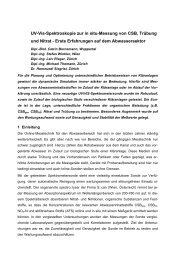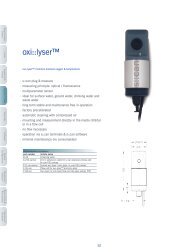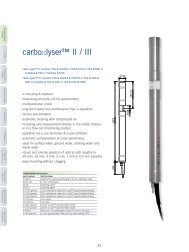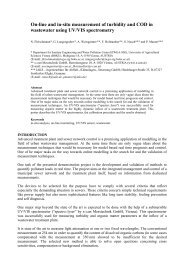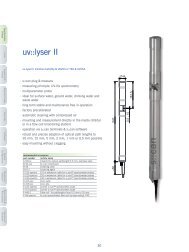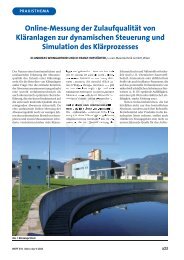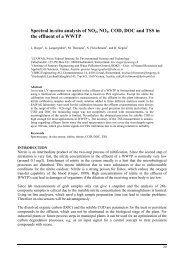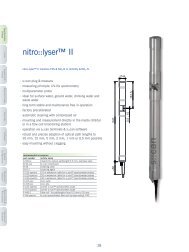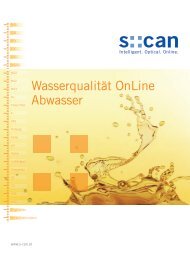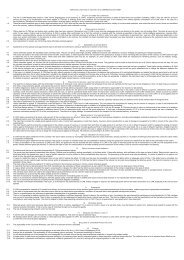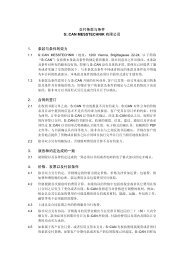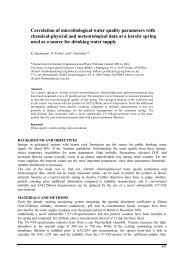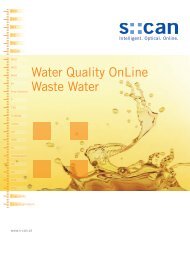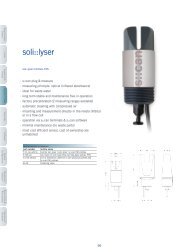Water Quality OnLine Drinking Water - S-can
Water Quality OnLine Drinking Water - S-can
Water Quality OnLine Drinking Water - S-can
Create successful ePaper yourself
Turn your PDF publications into a flip-book with our unique Google optimized e-Paper software.
Physical Probes<br />
“How do we measure”<br />
Just as all other s::<strong>can</strong> instruments the s::<strong>can</strong> physical probes <strong>can</strong><br />
be operated according to the “plug & measure” principle. With a<br />
simple plug connection, which provides power supply and data<br />
communication, the s::<strong>can</strong> probes are connected to an s::<strong>can</strong> terminal<br />
and are ready for use. All s::<strong>can</strong> probes are pre-calibrated ex<br />
works and do not require any conditioning before they <strong>can</strong> be used<br />
- all <strong>can</strong> be used continuously (<strong>OnLine</strong>) and directly in the water<br />
(InSitu). The “plug & measure” principle avoids complex installation<br />
procedures on site and thus does not only save time during<br />
initial operation, but also reduces avoidable errors.<br />
The highly optimised design completely eliminates all moving<br />
parts in contact with the water. This reduces failures and maintenance<br />
dramatically.<br />
Using standardised mounting devices s::<strong>can</strong> physical probes <strong>can</strong><br />
be installed quickly and effortlessly, either submersed (InSitu) or<br />
in a fl ow through setup (by-pass, monitoring station).<br />
Like all other s::<strong>can</strong> instruments s::<strong>can</strong> physical probes are intelligent<br />
instruments - amongst others local calibrations are stored on<br />
the probes and auto-diagnosis procedures are used to ensure best<br />
possible operation.<br />
oxi::lyser (see fi g.1)<br />
is an optical multi-parameter probe that measures the concentration<br />
of dissolved oxygen and the temperature directly in the water.<br />
The oxi::lyser does not need a minimum fl ow to produce accurate<br />
readings and integrates the temperature measurement for On-<br />
Line correction. The sensing element, which uses the principle of<br />
fl uorescence for the oxygen measurement, is neither affected nor<br />
damaged by direct exposure to sunlight. Under normal conditions,<br />
fouling of the sensing element will not affect the results. However,<br />
to be sure that fouling is kept to a minimum, the oxi::lyser<br />
<strong>can</strong> be cleaned automatically with compressed air. The oxi::lyser<br />
uses no replaceable parts or consumables. Therefore, when operated<br />
properly there will be no costs for spare parts at all. For<br />
the oxi::lyser we guarantee replacement of spare parts free of<br />
charge for the fi rst three years after delivery (upon presenting the<br />
warranty card).<br />
condu::lyser (see fi g.2)<br />
is a multi-parameter probe that measures conductivity and temperature<br />
directly in the water. The condu::lyser does not require<br />
a minimum fl ow to produce accurate readings and uses the temperature<br />
to correct the conductivity measurement online. The<br />
4-electrode measurement of the electrical conductivity produces<br />
results that are practically independent of possible fouling. The<br />
condu::lyser uses no replaceable parts or consumables. Therefore,<br />
when operated properly there will be no costs for spare parts at all.<br />
pH::lyser (see fi g.3)<br />
is a multi-parameter probe that measures the pH value and temperature<br />
directly in the water. The pH::lyser uses the temperature<br />
to correct the result of the pH measurement online. The non-porous,<br />
solid-state reference electrode ensures excellent pH readings<br />
and a long lifetime of the electrode.<br />
redo::lyser<br />
is a probe that measures the oxidation-reduction potential (also<br />
known as redox potential) and temperature directly in the water.<br />
The non-porous, solid state reference electrode ensures excellent<br />
ORP readings and a long lifetime of the electrode.<br />
chlori::lyser<br />
chlori::lyser monitors free or total chlorine - mounted in a fl ow cell<br />
setup. Due to the membrane covered amperometric measuring<br />
principle, fl ow and pH fl uctuations of the water do not infl uence<br />
the measurement result. Additionally, the integrated temperature<br />
compensation and the special, third electrode completely eliminates<br />
potential interferences.<br />
Their unrivalled measurement features in combination with the lowest<br />
possible total costs - initial cost and foreseeable operational costs<br />
- make s::<strong>can</strong> sensors the most attractive solution available today.<br />
57<br />
© s::<strong>can</strong> Messtechnik GmbH<br />
Spectrometer<br />
Probes<br />
i::s<strong>can</strong> Ionselective<br />
Probes<br />
Physical Probes<br />
Terminals Software System Confi guration<br />
Monitoring<br />
Stations<br />
Spare Parts &<br />
Accessories<br />
Services &<br />
Solutions



